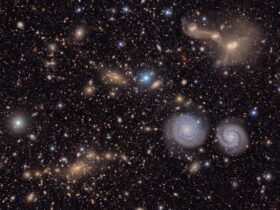A pair of spacecraft just launched to create hundreds of artificial solar eclipses in orbit.
The European Space Agency mission, called Proba-3, will allow scientists “to see an eclipse on demand,” as one satellite blocks the other’s view of the sun, says mission scientist and solar physicist Andrei Zhukov of the Royal Observatory of Belgium in Brussels.
That, in turn, will allow researchers to readily study the middle part of the corona, the uppermost region of the sun’s atmosphere. Scientists suspect that many of the sun’s most enduring mysteries, from how the solar wind is accelerated to why the corona is so much hotter than the surface of the sun, may have solutions in this elusive region. “It’s really a game changer,” Zhukov says.
The mission — launched from India on December 5 at 5:34 a.m. EST — consists of two satellites that will fly together in lockstep, as if they were a single rigid structure in space. While in formation, the satellites will stay 144 meters apart to an accuracy of one millimeter.
One satellite will, when directed, block the sun from the perspective of the other, emulating a total solar eclipse. The observing spacecraft will then send back high-resolution images of the innermost part of the sun’s diaphanous atmosphere.
Normally, scientists can use satellites to observe the corona right at the surface of the sun in extreme ultraviolet wavelengths of light. Scientists can also build an artificial eclipse into a telescope by putting a disk called a coronograph in front of the lens. But light waves bend around the sharp-edge disk in a process called diffraction, ruining the image. So the coronograph must block out a considerable area around the sun, limiting how close such observations can get to the star itself.
The in-between region, at distances from the surface of about one to three times the sun’s roughly 700,000-kilometer radius, can be observed only during a total solar eclipse (SN: 4/8/24). “But they are too rare,” Zhukov says. The alignment of sun, moon and Earth happens roughly once per year, can be viewed only from specific spots on the planet and lasts just a few minutes.
Proba-3 will create eclipses on demand that will last six hours. That long duration will let scientists see how the corona moves and changes over time.
And the large distance between the two spacecraft means diffraction is less of an issue. The farther away the occulter is, the more diffracted light can spread out before reaching the observer. It’s basically casting a sharper shadow, says physicist Amir Caspi of the Southwest Research Institute in Boulder, Colo.
“The cool thing about Proba-3 is they’re going to put the occulter much farther away than what you could reasonably do with a single spacecraft,” Caspi says. “That means that you can make the occulter exactly the right size, and you can see closer down to the solar surface.”
Staying in eclipse formation all the time would use too much fuel, so the satellites will spend most of their time flying freely. But scientists still expect more than 1,000 eclipses over the full two-year mission.
Precision formation-flying satellites will be useful for future missions, too. Such a setup could, for example, link several telescopes together to act as one, effectively creating a telescope much wider than anything that can be launched from Earth.
Caspi thinks the observations from Proba-3, in combination with other spacecraft, will set the stage for the next decade of solar science.
Sponsor Message
“It’s a very creative use of formation flying in space to achieve something that would be almost impossible, if not actually impossible, to do with a single spacecraft,” Caspi says. “It opens up this new discovery space of observations that have been inaccessible until now.”
Source link














Leave a Reply